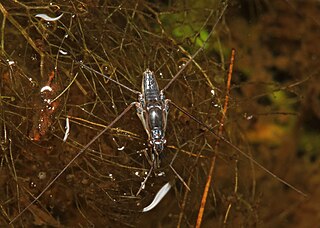
In Greek mythology and later art, the name Hesione refers to various mythological figures, of whom the Trojan princess Hesione is most known.

Chinchillas are either of two species of crepuscular rodents of the parvorder Caviomorpha. They are slightly larger and more robust than ground squirrels, and are native to the Andes mountains in South America. They live in colonies called "herds" at high elevations up to 4,270 m (14,000 ft). Historically, chinchillas lived in an area that included parts of Bolivia, Peru and Chile, but today, colonies in the wild are known only in Chile. Along with their relatives, viscachas, they make up the family Chinchillidae. They are also related to the chinchilla rat.

Huntsman spiders, members of the family Sparassidae, are known by this name because of their speed and mode of hunting. They are also called giant crab spiders because of their size and appearance. Larger species sometimes are referred to as wood spiders, because of their preference for woody places. In southern Africa the genus Palystes are known as rain spiders or lizard-eating spiders. Commonly, they are confused with baboon spiders from the Mygalomorphae infraorder, which are not closely related.

Skinks are lizards belonging to the family Scincidae, a family in the infraorder Scincomorpha. With more than 1,500 described species across 100 different taxonomic genera, the family Scincidae is one of the most diverse families of lizards. Skinks are characterized by their smaller legs in comparison to typical lizards and are found in different habitats except arctic and subarctic regions.

Hieracium , known by the common name hawkweed and classically as hierakion, is a genus of flowering plant in the family Asteraceae, and closely related to dandelion (Taraxacum), chicory (Cichorium), prickly lettuce (Lactuca) and sow thistle (Sonchus), which are part of the tribe Cichorieae. Hawkweeds, with their 10,000+ recorded species and subspecies, do their part to make Asteraceae the second largest family of flowering plants. Some botanists group all these species or subspecies into approximately 800 accepted species, while others prefer to accept several thousand species. Since most hawkweeds reproduce exclusively asexually by means of seeds that are genetically identical to their mother plant, clones or populations that consist of genetically identical plants are formed and some botanists prefer to accept these clones as good species whereas others try to group them into a few hundred more broadly defined species. What is here treated as the single genus Hieracium is now treated by most European experts as two different genera, Hieracium and Pilosella, with species such as Hieracium pilosella, Hieracium floribundum and Hieracium aurantiacum referred to the latter genus. Many members of the genus Pilosella reproduce both by stolons and by seeds, whereas true Hieracium species reproduce only by seeds. In Pilosella, many individual plants are capable of forming both normal sexual and asexual (apomictic) seeds, whereas individual plants of Hieracium only produce one kind of seeds. Another difference is that all species of Pilosella have leaves with smooth (entire) margins whereas most species of Hieracium have distinctly dentate to deeply cut or divided leaves.
A dry roadside dotted with small, ¾ inch red orange flowers, interspersed with very similar yellow ones, and often the white of daisies, is a good sign that you are in Hawkweed country.

Betty Lynn Buckley is an American actress and singer. Buckley is the winner of a Tony Award, and was nominated for two Daytime Emmy Awards, two Grammy Awards, and an Olivier Award. In 2012, she was inducted into the American Theater Hall of Fame.

The Integrated Taxonomic Information System (ITIS) is an American partnership of federal agencies designed to provide consistent and reliable information on the taxonomy of biological species. ITIS was originally formed in 1996 as an interagency group within the US federal government, involving several US federal agencies, and has now become an international body, with Canadian and Mexican government agencies participating. The database draws from a large community of taxonomic experts. Primary content staff are housed at the Smithsonian National Museum of Natural History and IT services are provided by a US Geological Survey facility in Denver. The primary focus of ITIS is North American species, but many biological groups exist worldwide and ITIS collaborates with other agencies to increase its global coverage.

Heartbreak House: A Fantasia in the Russian Manner on English Themes is a play written by George Bernard Shaw, first published in 1919 and first played at the Garrick Theatre in November 1920. According to A. C. Ward, the work argues that "cultured, leisured Europe" was drifting toward destruction, and that "Those in a position to guide Europe to safety failed to learn their proper business of political navigation". The "Russian manner" of the subtitle refers to the style of Anton Chekhov, which Shaw adapts.

Heteroceridae, the variegated mud-loving beetles, are a widespread and relatively common family of beetles found on every continent except for Antarctica.
Empire Capulet was a 7,044 GRT cargo ship which was built in 1943 for the Ministry of War Transport (MoWT). In 1946 she was sold and renamed Hesione. She served until 1960 when she was scrapped.
Crockerella hesione is a species of sea snail, a marine gastropod mollusk in the family Clathurellidae, the cone snails and their allies.

Crockerella is a genus of sea snails, marine gastropod mollusks in the family Clathurellidae.

iNaturalist is an American 501(c)(3) nonprofit social network of naturalists, citizen scientists, and biologists built on the concept of mapping and sharing observations of biodiversity across the globe. iNaturalist may be accessed via its website or from its mobile applications. As of 17 June 2023, iNaturalist users had contributed approximately 161,278,660 observations of plants, animals, fungi, and other organisms worldwide, and around 350,000 users were active in the previous 30 days.

Neogerris is a genus of water striders in the family Gerridae. There are about 13 described species in Neogerris.

Cymidae is a family of true bugs in the order Hemiptera. There are about 12 genera and at least 60 described species in Cymidae.

Geocoridae is a family of big-eyed bugs in the order Hemiptera. There are more than 290 described species in Geocoridae.

Trogiidae is a family of granary booklice in the order Psocodea. There are about 11 genera and more than 50 described species in Trogiidae.
Deretaphrus is a genus of dry bark beetles in the family Bothrideridae. A taxonomic revision of the genus published in 2013 listed 25 species, which exhibit a disjunct distribution. There are 22 species of the genus described from Australia, with single species also being found in each of New Caledonia, Bolivia, and North America.

Nanopsocetae is one of two major divisions of Troctomorpha in the order Psocodea, alongside Amphientometae. There are more than 20 families and 5,200 described species in Nanopsocetae.
















